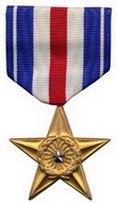George Kenmore
Ballplayers Decorated in Combat
| Date and Place of Birth: | March 10, 1915 Americus, GA |
| Date and Place of Death: | June 1, 1994 Montgomery, AL |
| Baseball Experience: | Minor League |
| Position: | Outfield |
| Rank: | Major |
| Military Unit: | 17th Field Artillery, US Army |
| Area Served: | Mediterranean Theater of Operations |
George V. Kenmore, the son of William (who ran a barbershop) and Lonie
Kenmore, was born in Americus, Georgia, on March 10, 1915. He attended
Sidney Lanier High School in Montgomery, Alabama, and went on to become
a successful athlete at Auburn. In 1937, he was the star halfback in
Orange Bowl game against Michigan State in 1937, and played varsity
baseball thru 1940. Kenmore also played baseball in the local textile
league with the Lanett team.
With the outbreak of World War II, Kenmore entered
military service with the army in 1940. He was a first lieutenant at
Fort Bragg, North Carolina, with the 17th Field Artillery,
and rose to the rank of captain. In December 1942, Captain Kenmore was
in North Africa and in the thick of the battle against Rommel’s Afrika
Korps. In March 1943, the artillery officer was awarded the Silver Star
for his part in the Battle of El Guettar. His citation stated:
“On three separate occasions during a period of 11
hours – March, 1943 – Tunisia, the command post from which major Kenmore
was directing fire was bombed and on one occasion a hand grenade, thrown
from a plane, destroyed a vehicle in the command post. Many times during
the day communications were disrupted by enemy bombs and shells, but
Major Kenmore kept communication open with radio and messengers. He
massed the fire of the battalion during the day stopping three tank
attacks and one infantry attack. His coolness in action and devotion to
duty are an inspiration to all, worthy of the finest traditions of the
armed forces and deserving the highest praise.”
Kenmore was a major when he returned to the United
States in 1944, and was stationed at Fort Sill, Oklahoma. With the war
over, Kenmore returned home. In February 1946, he was signed by former
Auburn football All-America Jimmy Hitchcock, who was the new baseball
manager of the Opelika Owls in the Class D Georgia-Florida League.
Hitchcock had been the backfield coach when Kenmore was at Auburn, and
George wasn’t the only former Auburn player that was signed. Bobby Day,
Dick Swindell and Charlie Rollo also signed for the Owls.
Kenmore’s minor league career was short-lived,
making just a handful of appearances for the Owls, before being released
in July. In 1947 he was assistant football coach at Opelika High School,
and began a veterinary practice in Montgomery in 1949. He was a
long-time member of the Alabama State Board of Veterinary Medical
Examiners and served at one point as their chairman.
Dr. Kenmore passed away on June 1, 1994, aged 79.
He is buried at Greenwood Cemetery in Montgomery, Alabama. His wife,
June, who was the first female cheerleader at Auburn, passed away in
June 2003.
Date Added December 19, 2019
Can you add more information to this biography and help make it the best online resource for this player? Contact us by email
Read Baseball's Greatest Sacrifice Through The Years - an online year-by-year account of military related deaths of ballplayers
Baseball's Greatest Sacrifice is associated with Baseball Almanac
Baseball's Greatest Sacrifice is proud to be sponsored by

